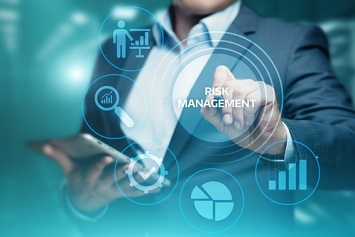As states reopen and lift stay-at-home or shelter-in-place orders related to the COVID-19 pandemic, businesses are building checklists of all the new policies and processes they need to have in place.
Beyond physical cleaning and adjusting workspaces to allow for social distancing, companies are also looking ahead at the potential risks of restarting. These include challenges around maintaining the health of employees while at the workplace and minimizing risks to the business should someone become ill.
But managing for these risks has not been a regular part of most Human Resources, financial, legal, safety, or management team roles in the past. It’s less tangible than guidelines set by the Occupational Safety and Health Administration (OSHA), and the application of workers’ compensation is murky at best, according to the National Council on Compensation Insurance (NCCI). A glimmer of hope may come in the form of technology, leveraging critical pieces of data that can alert to increased risk to employees and businesses.
The Data Conundrum
People who interact with others outside their home are at constant risk of contracting the coronavirus. There’s simply no way to avoid exposure without complete isolation. Because isolation is incompatible with today’s infrastructure of work, we must find a way to make the risk more manageable. One way to do this is through the collection and analysis of data as they relate to risk.
For example, employees can use an app on their phone to self-monitor their health and record any changes in temperature, COVID-like symptoms, or general well-being. They can also self-monitor their interactions such as close contact with other individuals who later tested positive for the coronavirus or indicated symptoms. In addition, technology such as Bluetooth and radio frequency can monitor proximity information and locations using smartphones.
When we aggregate data from a large group of employees, the data begin to tell a story; they give us a baseline for risk and allow us to identify if and when the risk level elevates.
One challenge, though, is collecting and analyzing these large volumes of data in a way that creates useful insights. Another challenge is accomplishing it in a way that supports data privacy for employees and their information.
Leveraging Technology
One path to a solution that manages collective employee data, safeguards privacy, and alerts to risk factors is to leverage artificial intelligence (AI) and machine learning-driven technology. Since the pandemic, enterprise software-as-a-service (SaaS) platforms have begun to emerge that provide location and proximity monitoring, contact tracing advanced privacy, and notifications of risk. Combined with a complementary mobile app, this type of solution enables full enterprise risk management.
Unlike large-scale government contact tracing programs or apps, these risk mitigation solutions are designed to be used within a business with one or more locations and are restricted to employees or third parties who opt in. Similarly, contact tracing and location data can be limited to areas within the office, campus, manufacturing facility, cafeteria, or other workplace locations, ensuring that locations visited outside of work are not tracked.
An effective approach to creating a risk assessment dashboard must use anonymized and secured employee data. A platform or dashboard should not collect and store data in a centralized database. Instead, contact tracing data should remain with the employee on his or her device, unless the employee explicitly shares the data with the employer. This allows for collection of important data but safeguards employee privacy.
Only if the risk factors indicate concern would an employee share his or her data with the employer. With the data, an employer would have clear direction on areas of the workplace that may require further sanitization and would be able to notify employees within the radius of the employee in question that the risk has been elevated. An effective platform would support this action without sharing the identity or status of the original at-risk employee with any employees outside of the HR function.
Risk Monitoring
Simply having an employee wellness and risk monitoring platform in place can, in theory, reduce liability. It indicates a proactive effort to manage wellness and safeguard employees if risks are elevated.
But organizations must have the processes in place to support such a platform, as well. Employee training and education is critical, helping employees understand the benefits of the system and ensuring proper use. Employees must also be comfortable with the system and understand that Bluetooth, rolling proximity identifiers (RPIDs), encryption, and tokens are designed to maintain privacy and security at the highest level.
For managers, having a dedicated leader to oversee and engage with the platform is also key. In many cases, an employee wellness and risk monitoring platform is integrated with other enterprise software systems such as human capital management, risk and liability, customer relationship management (CRM) platforms, and more. Having a plan to deploy, maintain, train, and manage oversight of a platform and disseminate information in a respectful and risk-mitigating way is key to success.
 Gopal Parvathaneni is CEO of EPSoft Technologies, a global software company that leverages intelligent AI, machine learning, automation, and big data to optimize critical business processes. He is cofounder of Virtual PPE, an employee wellness and risk mitigation platform to help businesses during the pandemic. Gopal Parvathaneni is CEO of EPSoft Technologies, a global software company that leverages intelligent AI, machine learning, automation, and big data to optimize critical business processes. He is cofounder of Virtual PPE, an employee wellness and risk mitigation platform to help businesses during the pandemic. |
 Mike Magnifico is a partner at Liberty Advisor Group, a goal-oriented, client-focused, and results-driven technology consulting firm. Liberty enables organizations to quickly stabilize operations while recalibrating for the long term during times of change and crisis. Mike Magnifico is a partner at Liberty Advisor Group, a goal-oriented, client-focused, and results-driven technology consulting firm. Liberty enables organizations to quickly stabilize operations while recalibrating for the long term during times of change and crisis. |

